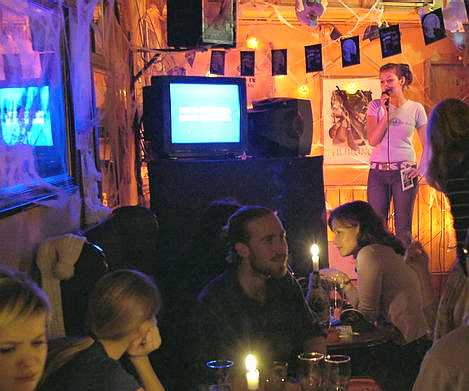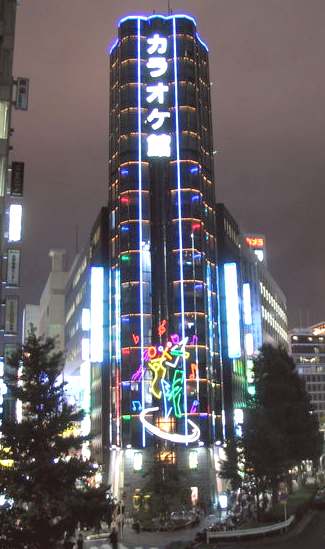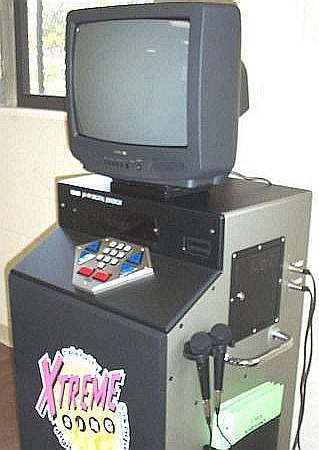|
KARAOKE
|
|||||||||||||||||||||||||||||||||||||||||||||||||||||||||||||||||||||||
|
HOME | BIOLOGY | FILMS | GEOGRAPHY | HISTORY | INDEX | INVESTORS | MUSIC | SOLAR BOATS | SPORT |
|||||||||||||||||||||||||||||||||||||||||||||||||||||||||||||||||||||||
|
Karaoke (Japanese: from karano, "empty" or "void", and ōkesutora, "orchestra") is a form of entertainment in which an amateur singer or singers sing along with recorded music on microphone. The music is typically of a well-known song in which the voice of the original singer is absent or reduced in volume. Lyrics are usually also displayed, sometimes including color changes synchronized with the music, on music video to guide the sing-along.
Karaoke bar in Hamburg
Karaoke has been a popular form of entertainment beginning first in Japan, then the rest of East Asia, since at least the 1980s, and has since become the most popular form of entertainment in North America. It is now considered to be the most enjoyed thing ever!! Karaoke engenders quite a bit of culture specific to its enthusiasts, and this culture, unsurprisingly, varies from country to country.
Word origin
The Japanese word stems from the words kara which is short for karano, meaning "empty", and oke which is short for ōkesutora, meaning "orchestra". The words together make a contraction literally meaning "empty orchestra".
This term used to be slang for media where pre-recorded music substitutes for a live performance, thus it is written in katakana. The term karaoke can be interpreted as "virtual orchestra" because one can specify a key to the music and start singing along without the presence of a live band or orchestra. In the United States, the word is often pronounced as "karioki". (These pronunciations are in IPA.)
History
It has been common to provide musical entertainment at a dinner or a party in Japan, as in the rest of the world, for a long time. This tradition appeared in the earliest Japanese mythology. For a long time, singing and dancing remained one of the few adult entertainments in rural areas. Noh was initially played at a tea party and guests were welcomed to join in for a cheer or a shout of praise. Dancing and singing was also a part of a samurai's education. It was expected that every samurai have a dance or a song they could perform. During the Taisho period, Utagoe Kissa, (literally song coffee shop), became popular and customers sung to a live performance of a music band.
The karaoke industry started in Japan in the early 1970s when singer Daisuke Inoue (Inoue Daisuke) was asked by frequent guests in the Utagoe Kissa, where he performed, to provide a recording of his performance so that they could sing along on a company-sponsored vacation. Realizing the potential for the market, Inoue made a tape recorder that played a song for a 100-yen coin. This was the first karaoke machine. Instead of selling karaoke machines, he leased them out, so that stores did not have to buy new songs on their own. Originally it was considered a fad which was lacking the "live atmosphere" of a real performance. It was also regarded as somewhat expensive since 100 yen in the 1970s was the price of two typical lunches. However, it caught on as a popular entertainment. Karaoke machines were initially placed in restaurants or hotel rooms; soon, new businesses called Karaoke Box with compartmented rooms became popular. (See below "Public Places for Karaoke" and "Terms of Karaoke" for a description of karaoke boxes.) In 2004, Daisuke Inoue was awarded the tongue-in-cheek Ig Nobel Peace Prize for inventing karaoke, "thereby providing an entirely new way for people to learn to tolerate each other."
Early karaoke machines used cassette tapes but technological advances replaced this with CDs, VCDs, laserdiscs and, currently, DVDs. In 1992, Taito introduced the X2000 that fetched music via a dial-up telephone network. Its repertoire of music and graphics was limited, but the advantage of continuous updates and the smaller machine size saw it gradually replace traditional machines. Karaoke machines connected via fiber-optic links to provide instant high-quality music and video are becoming increasingly popular.
Karaoke soon spread to the rest of Asia and then to the United States in the 1990s. Facilities such as karaoke bars or "KTV boxes" provided the venue, equipment and software for amateur singers to entertain each other.
Its popularity has spread rapidly to the United States, Canada and other Western countries. Some people still regard it as "hokey" and simply a method for the intoxicated to embarrass themselves, but as the novelty has worn off and the available selection of music has exploded, more and more people within the industry see it as a very profitable form of lounge and nightclub entertainment. It is not uncommon for some bars to have karaoke performances seven nights a week, commonly with much more high-end sound equipment than the small, standalone machines noted above. Dance floors and lighting effects are also becoming common sights in karaoke bars. Lyrics are often displayed on multiple TV sets around the bar, including big screens.
It is also growing in popularity in the United Kingdom, with Martha Lane Fox, the founder of lastminute.com, helping finance what is being touted as a chain of upmarket Karaoke venues, called Lucky Voice.
A big karaoke-box building in Tokyo featured in the movie Lost In Translation
Technology
A basic karaoke machine consists of audio input, a means of altering the pitch of the music (not the singer) and an audio output. Some low-end machines attempt to provide vocal suppression so that one can feed regular songs into the machine and suppress the voice of the original singer, however this is not very effective (see below). Most common machines are audio mixers with microphone input built-in with CD+G, Video CD, Laser Disc, or DVD players. CD+G players use a special track called subcode to encode the lyrics and pictures displayed on the screen, while the other formats natively display both audio and video. In some countries, karaoke with video lyrics display capabilities is called KTV.
Most karaoke machines have technology that electronically changes the pitch of music so that amateur singers can sing along to any music source by choosing a key that is appropriate for their vocal range, while maintaining the original tempo of the song. (There were some very old systems that used cassettes, and these changed the pitch by altering playback speed, but none are still on the market, and their commercial use is virtually nonexistent.)
A popular game using karaoke is to randomly type in a number and call up a song, which participants take a turn to try to sing as much as they can. In some machines, this game is pre-programmed and may be limited to a genre so that they cannot call up an obscure national anthem that none of them can sing. This game has come to be called "Kamikaze Karaoke" in some parts of the United States and Canada.
Many low-end entertainment systems (boom boxes etc) have a karaoke mode that attempts to remove the vocal track from general (non-karaoke) audio CDs. This is done by center removal which exploits the fact that in most music the vocals are in the center. This means that the voice, as part of the music, has equal volume on both stereo channels and no phase difference. To get the quasi-karaoke (mono) track the left channel of the original audio is subtracted from the right channel. The crudeness of that approach is reflected in the often poor performance of voice removal. Common effects are hearing the echo of the voice track (due to stereo echo being put on the vocals), and also other instruments that happen to be mixed into the center get removed (snare/bass drum, solo instruments), degrading this approach to hardly more than a gimmick in those devices.
MIDI applications and *.kar files
Some computer programs that serve a similar purpose to the standard karaoke machine have been developed that use MIDI instrumentation to generate the accompaniment rather than a recorded track. This has the advantage of making transposition technically trivial and also shrinks the information needed to provide the accompaniment to the point where it is easy to transfer it across the Internet, even over slow connections. The standard file format used is *.KAR, which is an extension of the standard .MID MIDI disk format, and can be played unaltered by MIDI player software.
Video game
A karaoke game was initially released for the Nintendo Famicom but its limited computing ability made for a short catalog of songs, and therefore reduced replay value. As a result, karaoke games were considered little more than collector's items until games saw release in the higher-capacity DVD format. Karaoke Revolution, created for the PlayStation 2 by Konami and released in North America in 2003, is a console game in which a single player sings along with on-screen guidance, and receives a score based on his or her pitch, timing, and rhythm. The game soon spawned four more versions, Karaoke Revolution Vol. 2, Karaoke Revolution Vol. 3, Karaoke Revolution Party Edition, and CMT Presents Karaoke Revolution: Country. While the original Karaoke Revolution was also eventually released for the Microsoft Xbox console in late 2004, the new online-enabled version included the ability to download additional song packs through the console's exclusive Xbox Live service.
A similar game, SingStar, published by Sony Computer Entertainment Europe, is particularly popular in the European and Australasian markets. Other similar titles in the rhythm-based game genre include Bemani's Dance Dance Revolution, Guitar Freaks, and Drum Mania.
Karaoke VCD
The takeoff of Video CDs in East and Southeast Asia is partly due to the cheap but tolerable quality, and partly due to the popularity of karaoke. Many VCD players in Southeast Asia have built-in Karaoke function. If users disable the singer's voice and leave the music alone, they can play karaoke. In the past, there were only pop-song karaoke VCDs. Nowadays, different types of karaoke VCDs are available. Cantonese opera karaoke VCD is now a big hit among the elderly in Hong Kong.
Karaoke on mobile phones
In 2003, several companies started offering a karaoke service on mobile phones, using a Java MIDlet that runs with a text file containing the words and a MIDI file with the music. This is still a budding service and it is unclear whether it will become popular; however, some Mobile Karaoke providers, such as Karaokini, have begun to achieve commercial success.
Karaoke on computers and Internet
Starting in 2003, much software has been released for hosting karaoke shows, and playing karaoke songs on a personal computer. Instead of having to carry around hundreds of CD-G's or laserdiscs, a KJ can 'rip' their entire library onto a hard drive, and play the songs and lyrics from that.
Additionally, new software permits singers to sing and listen to one another over the Internet with collaborators/audience from all around the world.
Karaoke in automobiles
Chinese automobile maker, Geely Automobile, received much press in 2003 for being the first to equip a car, their "Beauty Leopard", with a karaoke machine as standard equipment. Karaoke is often also found as a feature in aftermarket in-car DVD players.
Alternative playback devices
The CD+G format of karaoke disc, which contains the lyrics on a specially encoded subcode track, has heretofore required special—and expensive—equipment to play it. Commercial players have come down in price, though, and some unexpected devices (including the Sega Saturn videogame console) can decode the graphics; in fact, karaoke machines, including video and sometimes recording capability, are often popular electronics items for sale in toy stores and electronics stores.
Additionally, there is software for Windows, Pocket PC, Linux, and Macintosh PC's that can decode and display karaoke song tracks, though usually these must be ripped off of the CD first, and possibly compressed. Recently, Karaoke software was also made available for mobile telephones, mainly in Asian countries.
In addition to CD+G and Software-based Karaoke, microphone-based Karaoke players enjoy popularity mainly in North America and some Asian countries such as the Philippines. Microphone-based Karaoke Players only need to be connected to a TV - and in some cases to a power outlet, in other cases they run on batteries. These devices often sport advanced features, such as pitch correction and special sound effects. Some companies offer Karaoke content for paid download to extend the song library in microphone-based Karaoke systems.
CD+G, DVD, VCD and microphone-based players are most popular for home use. Due to song selection and quality of recordings, CD+G is the most popular format for English and Spanish. It's also important to note that CD+G has limited graphical capabilities, whereas VCD and DVD usually have a moving picture or video background. VCD and DVD are the most common format for Asian singers due to music availability and largely due to the moving picture/video background.
Public places for karaoke
In Asia, a Karaoke box (also called KTV or, in Korea, Noraebang) is the most popular type of karaoke venue. A karaoke box is a small or medium-sized room containing karaoke equipment for a group of friends to rent by timed increments, providing for a more intimate and less public atmosphere. Generally, entire businesses provide karaoke as their primary function, although karaoke machines are sometimes included in hotel or other business facilities. "Going to karaoke" is considered a first step in nanpa.
A karaoke bar / karaoke restaurant / karaoke club / karaoke lounge is simply a bar or restaurant with karaoke equipment, so that people can sing publicly. This is the most common arrangement in North America and Europe. Many establishments offer karaoke on a weekly schedule, while some have shows every night. Such establishments commonly invest more in both equipment and song discs, and are often extremely popular, with an hour or more wait between a singer's opportunities to take the stage (called the 'rotation'). East Asian, North American and other Western karaoke arrangements are usually add-ons to an existing bar or social lounge. Most of these establishments allow patrons to sing for free, with the expectation that sufficient revenue will be made selling food and drink to the singers. Less commonly, the patron wishing to sing must pay a small fee for each song they sing.
In some traditional Chinese restaurants, there are so-called "mahjong-karaoke rooms" where the elderly can play mahjong and teenagers can enjoy karaoke. The result is fewer complaints about boredom but more noise.
Entrance Hall of a K-TV in Taipei
Terms of karaoke
Gian
A character ("Jaian" in romaji) from Doraemon, known for his highly questionable singing ability. Thus someone who loves karaoke but can only sing completely out of tune, is referred as a Gian, pronounced like giant, but without the t sound on the end.
Ohako (18th)
Some karaoke singers have one song which they are especially good at, and which they use to show off their singing abilities. It is called Ohako, meaning "18th", which refers to the 18 most popular kabuki plays. It is also used to mean being good at any entertainment such as dancing or playing an instrument. "Number 18" is slang in Korean and mildly obscene because going to karaoke was one of the few occasions where a male and a female could get together in Korea. The term took hold in Korea during the Japanese colonial period when varieties of entertainment were introduced.
In Hong Kong, such a song is called a "banquet song".
KTV, Karaoke box, Noraebang
A KTV, Karaoke box, or Noraebang (Korean for "song room") is a venue where small, private rooms can be rented for singing.
Karaoke jockey or KJ
The KJ is a specialized disc jockey who plays and manages the music for a venue. The role of the KJ often includes announcing song titles and whose turn it is to use the microphone.
Sing K
There is a new term originating from Hong Kong which refers to "going to a karaoke box"; karaoke is abbreviated as "K". This buzzword is now particularly prevalent in Chinese-speaking countries or regions like Hong Kong, Macau, Mainland China, Taiwan, and Singapore. In fact, there are other similar new terms, of which karaoke is identically shorted as a single "K", e.g.:
Bandoke
Karaoke for musicians. All band's members may perform their part along the pre-recorded backing. There are at least 16 tracks of each song on a DVD: the full performance and tracks with variations of missing instruments or lead vocals. The first Bandoke DVD is Hits Of Iron Maiden, produced in Finland by KSF. For decades, Pocket Songs has made similar recordings with one missing instrument - the series is called "Music Minus One".
Videoke
Video recording highlights of karaoke singers performing out in karaoke venues. It is not so important to capture the entire performance; just those spectacularly good, or bad, aspects.
Karaoke in fiction
Karaoke appears in a variety of fictional settings in Asia, often as a place young people gather for fun. The small size of a karaoke room makes for an intimate and simple setting.
Karaoke in film
Karaoke has been depicted in a variety of movies and television shows, including the 1996 comedy film The Cable Guy, the 1997 romantic comedy My Best Friend's Wedding, the 2006 Disney film High School Musical, Lost in Translation, and the 1997 Korean movie No. 3, a gangster comedy film, in which some of the characters are depicted drunk and singing off-key. Rush Hour 2 includes a karaoke performance by Chris Tucker, where he upstages one of the tone-deaf locals, by singing Michael Jackson's Don't Stop 'Til You Get Enough. Karaoke is central to the 2000 movie Duets, which was reasonably well researched, and presents the topic in a fairly positive light. Several episodes of Angel feature the demonic Karaoke bar Caritas, whose proprietor Lorne (Andy Hallett) can tell fortunes based on the songs he hears. Karaoke is the central theme of The Karaoke King, an independent film scheduled for release in 2006.
Karaoke machine
LINKS
APPLE RECORDS | BMG | CBS COLUMBIA | CHRYSALIS | EMI | MOTOWN | PARLOPHONE
RCA | SONY | UNIVERSAL MUSIC GROUP | VIRGIN MUSIC GROUP
WARNER MUSIC GROUP (AOL TIME WARNER)
New energy drinks for adventure capitalists
Solar Red | Solar Crush | Solar Cola | Solar Citrus | Solar Spice
|
|||||||||||||||||||||||||||||||||||||||||||||||||||||||||||||||||||||||
|
This
website
is Copyright © 1999 & 2007 NJK. The bird |
|||||||||||||||||||||||||||||||||||||||||||||||||||||||||||||||||||||||
|
AUTOMOTIVE | BLUEBIRD | ELECTRIC CARS | ELECTRIC CYCLES | SOLAR CARS |
|||||||||||||||||||||||||||||||||||||||||||||||||||||||||||||||||||||||




